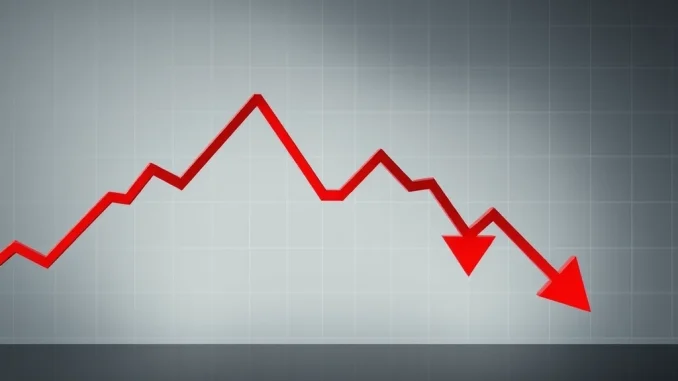
Brace yourselves, investors! The US stock market just took a significant tumble. In a session that left many traders on edge, all three major U.S. stock market indices – the S&P 500, Nasdaq, and Dow Jones – closed in the red. But what does this stock market drop really mean, and what’s causing this tremor in the financial world? Let’s dive into the details and unpack what’s happening in the markets.
Why Did the Stock Market Drop? Decoding the Market Correction
On [Insert Date], the markets witnessed a broad sell-off, pushing key indices lower. Here’s a snapshot of the day’s closing figures:
| Index | Change |
|---|---|
| S&P 500 | -1.12% |
| Nasdaq | -2.04% |
| Dow Jones Industrial Average | -0.31% |
But simply stating the numbers doesn’t tell the whole story. To truly understand this market correction, we need to look beyond the percentages and delve into the potential factors driving this downturn.
- Inflation Fears Persist: Despite some signs of cooling, inflation remains a significant concern. Investors are worried that persistent inflation could force the Federal Reserve to maintain or even increase its aggressive interest rate hikes. Higher interest rates can make borrowing more expensive for companies, potentially slowing down economic growth and impacting corporate profits.
- Interest Rate Hikes Looming: The anticipation of further interest rate increases by the Federal Reserve is a major headwind. The market is closely watching for any signals from the Fed regarding future monetary policy. Hawkish comments or strong economic data can fuel fears of continued rate hikes, leading to market pullbacks.
- Economic Slowdown Concerns: Coupled with inflation and interest rate worries, there’s growing anxiety about a potential economic slowdown or even a recession. Economic data, while mixed, has shown some signs of weakening, adding to investor unease.
- Geopolitical Uncertainties: Global events and geopolitical tensions always play a role in market sentiment. Uncertainties in various parts of the world can contribute to risk aversion and prompt investors to move away from equities.
It’s a complex interplay of these factors that often leads to a market correction. It’s not always one single event, but rather a confluence of concerns that weighs on investor sentiment.
Decoding Investor Sentiment: Fear Grips the Market
Market movements are often driven by emotions as much as by fundamentals. In times of uncertainty, investor sentiment can quickly turn negative. When fear takes hold, investors tend to become more risk-averse, leading to selling pressure across the board.
Several indicators point towards a shift in investor sentiment:
- Increased Volatility: The CBOE Volatility Index (VIX), often referred to as the “fear gauge,” typically rises during market downturns. Increased volatility signals heightened uncertainty and anxiety among investors.
- Flight to Safety: In times of market stress, investors often seek refuge in safer assets like government bonds or gold. This “flight to safety” can exacerbate selling pressure in equities.
- Negative News Cycle: A constant stream of negative news headlines related to inflation, interest rates, and economic growth can further dampen investor spirits and fuel bearish sentiment.
Understanding investor sentiment is crucial because it can often amplify market movements. When fear becomes the dominant emotion, even fundamentally sound assets can experience temporary price declines.
Navigating Market Volatility: What Should Investors Do?
Periods of market volatility can be unsettling, but they also present opportunities for informed investors. Instead of panicking, consider these actionable insights:
- Stay Calm and Don’t Panic Sell: Market corrections are a normal part of the investment cycle. Resist the urge to make impulsive decisions based on fear. Panic selling can lock in losses and prevent you from participating in any potential rebound.
- Review Your Portfolio: Take this opportunity to reassess your portfolio’s asset allocation and risk tolerance. Ensure your investments still align with your long-term financial goals.
- Consider Dollar-Cost Averaging: If you have cash on the sidelines, consider dollar-cost averaging into the market. This strategy involves investing a fixed amount of money at regular intervals, regardless of market fluctuations. It can help reduce the risk of investing a lump sum at the wrong time.
- Focus on Long-Term Fundamentals: In times of market noise, it’s essential to focus on the long-term fundamentals of the companies and assets you invest in. Strong companies with solid earnings potential are more likely to weather market storms.
- Seek Professional Advice: If you’re feeling overwhelmed or unsure about how to navigate market volatility, consult with a qualified financial advisor. They can provide personalized guidance based on your individual circumstances.
Market volatility is inevitable. The key is to have a well-thought-out investment strategy and stick to it, even during turbulent times. Remember, downturns can create opportunities for long-term growth.
Economic Uncertainty: The Road Ahead
The current economic uncertainty is palpable. The interplay of inflation, interest rates, and economic growth is creating a complex and unpredictable environment. While the recent stock market drop is a cause for concern, it’s crucial to maintain a balanced perspective.
Looking ahead, several factors will influence market direction:
- Inflation Data: Upcoming inflation reports will be closely watched for any signs of further cooling or persistence.
- Federal Reserve Policy: The Fed’s future interest rate decisions and communication will be critical in shaping market expectations.
- Economic Growth Indicators: Data on GDP growth, employment, and consumer spending will provide insights into the health of the economy.
- Corporate Earnings: The upcoming earnings season will offer a glimpse into how companies are performing in the current economic climate.
Navigating this period of economic uncertainty requires vigilance, patience, and a long-term perspective. While short-term market fluctuations are unavoidable, focusing on sound investment principles and staying informed can help investors weather the storm and position themselves for future success.
In Conclusion: Decoding the Market’s Message
The recent stock market drop serves as a stark reminder of the inherent volatility and uncertainty in financial markets. While the immediate reasons may be multifaceted, the underlying theme is one of heightened economic anxiety and shifting investor sentiment. Understanding the dynamics of market correction and market volatility is crucial for making informed investment decisions.
Instead of succumbing to fear, view this period as an opportunity to reassess, rebalance, and potentially reposition your portfolio for the long term. By staying informed, maintaining a disciplined approach, and focusing on your long-term financial goals, you can navigate these turbulent waters and emerge stronger on the other side. The market’s message is clear: caution and preparedness are paramount in this evolving economic landscape.




Be the first to comment